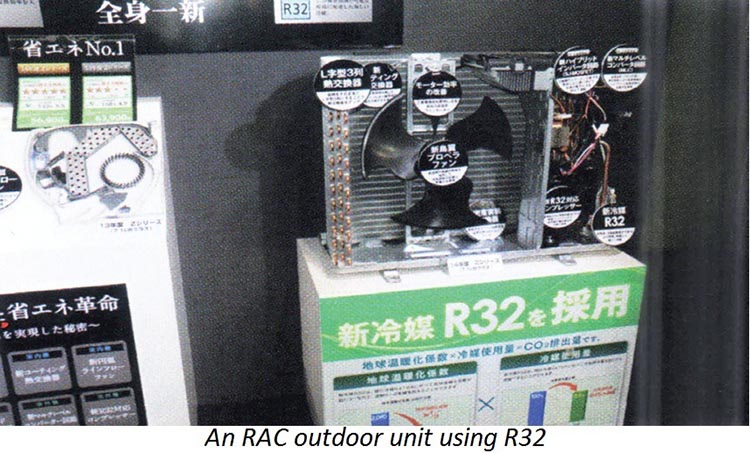While the direction the global air conditioner market will take in selecting next-generation alternative refrigerants is still uncertain, momentum in Japan to adopt R32 as the next-generation air conditioner refrigerant is visibly building. The debate over R32’s mild flammability and environmental load has gone on for some time among air conditioner manufacturers in Japan, but a consensus finally seems to have been reached to adopt the refrigerant in their room air conditioners (RACs). Following Daikin’s product launch announcement last fall, major manufacturers including Mitsubishi Electric, Panasonic, and Hitachi have all announced the launch of premium models that use R32 refrigerant for the Japanese market this fall.
In November 2012, Daikin released its Uru-Sara 7 series of RACs that use R32 refrigerant in Japan, a world first. The Uru- Sara 7 has enjoyed strong popularity in the Japanese market, achieving cumulative sales of more than 200,000 units up to September 2013. Following these brisk sales, Daikin moved to adopt R32 in all of its wall-mounted RAC models for the Japanese market, whose cumulative sales as of September 30, 2013, was estimated to surpass 1 million units.
Mitsubishi Electric is releasing 11 models in its premium Kirigamine Z series from early November as new products for 2014. The new models adopt R32 refrigerant and a high efficiency compressor that reduces refrigerant compressor loss. Mitsubishi Electric is planning a total monthly production volume of 20,000 units for the series.
Panasonic has also adopted new refrigerant R32 in its 2014 model RACs in the X series to be released in phases starting November 1.
Starting in late October, Hitachi Appliances is releasing a total of nine models in its new Stainless Clean Shirokuma-kun Z series that adopt R32 refrigerant. It is planning a monthly production volume of 30,000 units for the series.
Other Japanese manufacturers are also preparing to launch R32 RAC models in the Japanese market. Not stopping at the Japanese market, these air conditioner manufacturers are also moving to launch R32 models in the global market.
Planning is underway for a public-private collaboration to support R32 conversion in Thailand. Fujitsu General has also recently launched R32 RACs in the Australian market.
Amid these moves, Gree, Midea, and other Chinese manufacturers are also actively moving to define their course for next-generation refrigerants. In addition to releasing RAC models that adopt R290 (propane), they are also racing to develop R32 RACs and packaged air conditioners (PACs) and are exhibiting these new products at trade fairs in China and overseas.
Major global manufacturers of compressors and components are also closely watching next-generation refrigerant trends and are actively developing products adapted for use with R32. Guangdong Meizhi Compressor (GMCC), one of the world’s largest rotary compressor manufacturers, says that the company had updated its mass-production system to be able to immediately respond to demand for both R290 and R32 compressors. Highly and other major rotary compressor manufacturers are exhibiting products designed for the new refrigerants at trade fairs around the world.
Leading manufacturers in the scroll compressor field have also developed products compatible with the new refrigerants. Copeland has developed R290 and R32 compressors, while Dalian Sanyo (Panasonic) is producing R32 compressors. Danfoss, Sanhua, Saginomiya, and other leading component manufacturers exhibited components designed for the new refrigerants at the China Refrigeration (CRH) Expo 2013. A lubricant manufacturer presented a paper on lubricant applications compatible with R32 and other new refrigerants at the International Symposium on New Refrigerants and Environmental Technology 2012 (Kobe Symposium 2012) organized by the Japan Refrigeration and Air Conditioning Industry Association (JRAIA).
R32 has a global warming potential (GWP) of 675, a 68% lower than R41OA’s GWP of 2,090 according to the Intergovernmental Panel on Climate Change (IPCC) 4th Assessment Report. R32 is also said to achieve higher efficiency both under part-load and full-load conditions. As a single component refrigerant, it does not suffer from glide and is easy to recycle. On the other hand, R32 is classified as A2L, or mildly flammable, by ASHRAE.
Japanese air conditioner manufacturers conducted repeated tests of RACs using R32 refrigerant to verify its safety and concluded that there were no problems. JRAIA is now focusing on determining whether there are safety risks associated with using R32 in PACs and VRF systems, which have a relatively large refrigerant charge. Use of R32 in these systems is currently subject to legal restrictions in Japan.
New refrigerants challenging R32 are also being launched in the market. Honeywell is promoting new refrigerant L41 , an HFO based blend it has developed. Some Japanese manufacturers have started performance testing of L41 and many aspects need to be verified against R32, including its practical applicability, energy efficiency, and cost performance.
(Source: JARN, October 25, 2013)
Disclaimer: The information provided within this publication / eBook/ content is for general informational purposes only. While we try to keep the information up-to-date and correct, there are no representations or warranties, express or implied, about the completeness, accuracy, reliability, suitability or availability with respect to the information, products, services, or related graphics contained in this publication / eBook/ content for any purpose. Any use of this information is at your own risk.
 Youth
Youth
 Women
Women
 Research for Ishrae
Research for Ishrae







